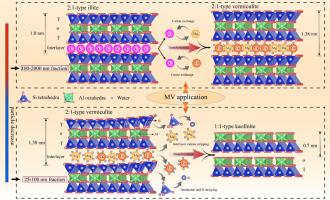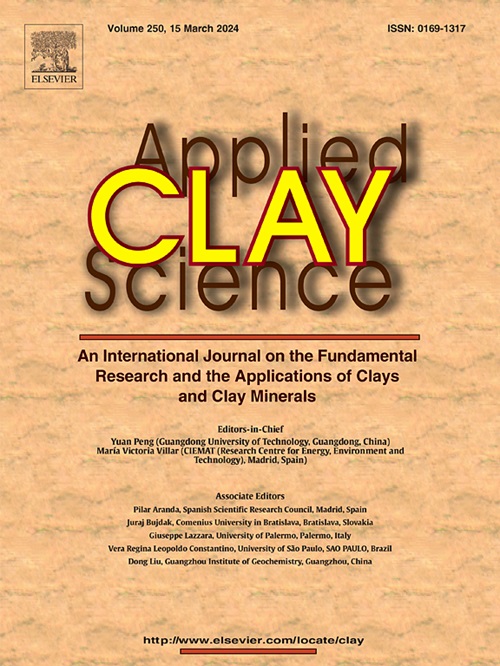Clay minerals transformation in soil particles of Udic Ferrisols under 36-year Chinese milk vetch application in southern China
IF 5.3
2区 地球科学
Q2 CHEMISTRY, PHYSICAL
引用次数: 0
Abstract
To elucidate the impact of green manure application on soil clay minerals, surface soil samples (0–20 cm) were collected from Udic Ferrisols developed from Quaternary clay sediments, under no fertilization (CK) and Chinese milk vetch (MV) application treatments, based on a 36-year long-term experiment in southern China. Synchrotron X-ray diffraction (XRD), thermogravimetric analysis (TG), 27Al and 29Si nuclear magnetic resonance (NMR), electron paramagnetic resonance (EPR), and high-resolution transmission electron microscopy (HRTEM) were employed to investigate the composition and structural characteristics of clay minerals in soil particles (100–2000 nm and 25–100 nm). The clay minerals in the 100–2000 nm and 25–100 nm particles were mainly kaolinite and illite, containing a minor amount of vermiculite. As the particle size decreased to the nanoscale (25–100 nm), the kaolinite content increased, the vermiculite content decreased, and the crystallinity of the clay minerals weakened. Aluminum (Al) in the structure of the clay minerals mainly existed as octahedral coordinated Al (VIAl), with a small proportion of tetrahedral coordinated Al (IVAl) (5.8 %–18.4 %) predominantly as Q3(1Al) (where silicon (Si) in the tetrahedron was connected to three neighboring Si atoms through oxygen to form a framework structure). The abundance of IVAl decreased significantly with decreasing particle size, and the structure of the clay minerals gradually shifted from a 2:1 to a 1:1 type. In the 100–2000 nm particles, MV application reduced illite content and increased IVAl abundance. HRTEM observation revealed a transition of lattice fringes from 1.0 nm to 1.38 nm. Conversely, in the 25–100 nm particles, MV application decreased IVAl abundance and increased kaolinite content, with the 1.38 nm lattice fringes gradually transformed into 0.71 nm. These findings indicate that long-term MV incorporation promoted the transformation of illite to vermiculite in the 100–2000 nm particles and vermiculite to kaolinite in the 25–100 nm particles to a certain extent.

在中国南方施用中国牛奶草 36 年的乌迪克费里斯土壤颗粒中粘土矿物的转化
为了阐明施用绿肥对土壤粘土矿物的影响,根据在中国南方进行的一项为期 36 年的长期试验,在不施肥(CK)和施用中国牛奶菜(MV)处理下,从第四纪粘土沉积物发育而成的乌迪克费里斯土壤中采集了表层土壤样品(0-20 厘米)。采用同步辐射 X 射线衍射 (XRD)、热重分析 (TG)、27Al 和 29Si 核磁共振 (NMR)、电子顺磁共振 (EPR) 和高分辨率透射电子显微镜 (HRTEM) 研究了土壤颗粒(100-2000 nm 和 25-100 nm)中粘土矿物的组成和结构特征。100-2000 nm 和 25-100 nm 颗粒中的粘土矿物主要是高岭石和伊利石,含有少量蛭石。当粒度减小到纳米级(25-100 nm)时,高岭石含量增加,蛭石含量减少,粘土矿物的结晶度减弱。粘土矿物结构中的铝(Al)主要以八面体配位铝(VIAl)的形式存在,小部分四面体配位铝(IVAl)(5.8%-18.4%)主要以 Q3(1Al)(四面体中的硅(Si)通过氧与相邻的三个硅原子连接形成框架结构)的形式存在。随着颗粒尺寸的减小,IVAl 的丰度明显降低,粘土矿物的结构也逐渐从 2:1 型转变为 1:1 型。在 100-2000 nm 的颗粒中,MV 的应用降低了伊利石的含量,增加了 IVAl 的丰度。HRTEM 观察显示,晶格边缘从 1.0 纳米过渡到 1.38 纳米。相反,在 25-100 nm 的颗粒中,MV 的应用降低了 IVAl 的丰度,增加了高岭石的含量,1.38 nm 的晶格边缘逐渐转变为 0.71 nm。这些结果表明,在 100-2000 nm 的颗粒中,长期掺入 MV 在一定程度上促进了伊利石向蛭石的转化,在 25-100 nm 的颗粒中,促进了蛭石向高岭石的转化。
本文章由计算机程序翻译,如有差异,请以英文原文为准。
求助全文
约1分钟内获得全文
求助全文
来源期刊

Applied Clay Science
地学-矿物学
CiteScore
10.30
自引率
10.70%
发文量
289
审稿时长
39 days
期刊介绍:
Applied Clay Science aims to be an international journal attracting high quality scientific papers on clays and clay minerals, including research papers, reviews, and technical notes. The journal covers typical subjects of Fundamental and Applied Clay Science such as:
• Synthesis and purification
• Structural, crystallographic and mineralogical properties of clays and clay minerals
• Thermal properties of clays and clay minerals
• Physico-chemical properties including i) surface and interface properties; ii) thermodynamic properties; iii) mechanical properties
• Interaction with water, with polar and apolar molecules
• Colloidal properties and rheology
• Adsorption, Intercalation, Ionic exchange
• Genesis and deposits of clay minerals
• Geology and geochemistry of clays
• Modification of clays and clay minerals properties by thermal and physical treatments
• Modification by chemical treatments with organic and inorganic molecules(organoclays, pillared clays)
• Modification by biological microorganisms. etc...
 求助内容:
求助内容: 应助结果提醒方式:
应助结果提醒方式:


